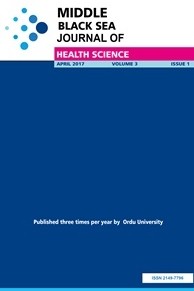Lactate as a Predictor for Determining Invasive Intervention Time in non-ST-Segment Acute Coronary Syndromes
Objective: The aim was to evaluate the correlation of lactate levels measured at admission with the urgency of intervention in patients diagnosed with non-ST-segment acute coronary syndromes (NST-ACS).Methods: This was a prospective observational study conducted in a research hospital between March 2020 and June 2021. Patients admitted to the emergency department with chest pain and diagnosed with NST-ACS were divided into four group according to the recommendations of the European Society of Cardiology (ESC) 2015 guidelines to determine the priority of invasive intervention. Lactate levels were measured from venous blood samples. Whether there was a difference in terms of lactate levels between patients who were recommended for early invasive intervention (within 24 hours) and patients who were recommended for late invasive intervention (within 72 hours) was investigated. The sample size was estimated with G*Power and statistical analysis was performed using SPSS 22.Results: The mean age of the group recommended for early intervention was 62±11.45 years and the mean age of the group recommended for late intervention was 61±11.89 years. The time interval between the beginning of symptoms and admission to the emergency department was similar between the groups and the median was 4 hours. GRACE scores were significantly higher in the early intervention recommended group. There was no difference in terms of lactate levels between the groups. Correlations between GRACE scores and lactate levels were statistically non-significant (p>0.05). Conclusion: Lactate alone was not a good predictor for risk analyses and determination of invasive intervention time in NST-ACS patients without urgent invasive intervention indications.
Keywords:
non-ST-segment acute coronary syndromes, early invasive intervention, late invasive intervention, lactate,
___
- 1. Liang D, Zhou X, Hong X, Feng X, Shan P, Xie Q, et al. Association between admission lactate levels and mortality in patients with acute coronary syndrome: a retrospective cohort study. Coron Artery Dis. 2019;30(1):26-32. doi: 10.1097/MCA.0000000000000674.
- 2. Li Y, Zhang Z, Xiong X, Cho WC, Hu D, Gao Y, et al. Immediate/Early vs. Delayed Invasive Strategy for Patients with Non-ST-Segment Elevation Acute Coronary Syndromes: A Systematic Review and Meta-Analysis. Front Physiol. 2017;27(8):952. doi: 10.3389/fphys.2017.00952.
- 3. 2015 ESC Guidelines for the management of acute coronary syndromes in patients presenting without persistent ST-segment elevation. European Heart Journal. 2016;37:267–315. doi:10.1093/eurheartj/ehv320
- 4. Bonello L, Laine M, Puymirat E, Lemesle G, Thuny F, Paganelli F, et al. Timing of Coronary Invasive Strategy in Non-ST-Segment Elevation Acute Coronary Syndromes and Clinical Outcomes: An Updated Meta-Analysis. JACC Cardiovasc Interv. 2016;9(22):2267-2276. doi: 10.1016/j.jcin.2016.09.017.
- 5. Jobs A, Mehta SR, Montalescot G, Vicaut E, Van't Hof AWJ, Badings EA, et al. Optimal timing of an invasive strategy in patients with non-ST-elevation acute coronary syndrome: a meta-analysis of randomised trials. Lancet. 2017;390(10096):737-746. doi: 10.1016/S0140-6736(17)31490-3.
- 6. Lazzeri C, Valente S, Chiostri M, Picariello C, Gensini GF. Lactate in the acute phase of ST-elevation myocardial infarction treated with mechanical revascularization: a single-center experience. Am J Emerg Med. 2012;30(1):92-6. doi:10.1016/j.ajem.2010.10.008
- 7. Lazzeri C, Valente S, Chiostri M, Gensini GF. Clinical significance of lactate in acute cardiac patients. World J Cardiol. 2015; 7(8): 483-9. doi: 10.4330/wjc.v7.i8.483
- 8. Williams TA, Martin R, Celenza A, Bremner A, Fatovich D, Krause J, et al. Use of serum lactate levels to predict survival for patients with out-of-hospital cardiac arrest: A cohort study. Emerg Med Australas. 2016; 28(2): 171-8. doi: 10.1111/1742-6723.12560
- 9. Eggers KM, Lindahl B. Prognostic Biomarkers in Acute Coronary Syndromes: Risk Stratification Beyond Cardiac Troponins. Curr Cardiol Rep. 2017;19(4):29. doi: 10.1007/s11886-017-0840-3.
- 10. Vermeulen RP, Hoekstra M, Nijsten MW, van der Horst IC, van Pelt LJ, Jessurun GA, et al. Clinical correlates of arterial lactate levels in patients with ST-segment elevation myocardial infarction at admission: a descriptive study. Crit Care. 2010;14(5):R164. doi: 10.1186/cc9253.
- 11. Gjesdal G, Braun OO, Smith JG, Scherstén F, Tydén P. Blood lactate is a predictor of short-term mortality in patients with myocardial infarction complicated by heart failure but without cardiogenic shock. BMC Cardiovasc Disord. 2018;18(1):8. doi: 10.1186/s12872-018-0744-1.
- 12. Vincent JL, Quintairos E Silva A, Couto L Jr, Taccone FS. The value of blood lactate kinetics in critically ill patients: a systematic review. Crit Care. 2016;20(1):257. doi: 10.1186/s13054-016-1403-5.
- 13. Fuller BM, Dellinger RP. Lactate as a hemodynamic marker in the critically ill. Curr Opin Crit Care. 2012;18(3):267-72. doi: 10.1097/MCC.0b013e3283532b8a.
- 14. Demers P, Elkouri S, Martineau R, Couturier A, Cartier R. Outcome with high blood lactate levels during cardiopulmonary bypass in adult cardiac operation. Ann Thorac Surg. 2000;70(6):2082-6. doi: 10.1016/s0003-4975(00)02160-3.
- 15. Chandrasekar HS, Devi AL. Serum Lactic Acid Levels, Lactate Clearance, and Uric Acid Levels as Prognostic Markers in Acute Coronary Syndrome Patients. Int J Sci Stud 2016;4(6):23-26. doi: 10.17354/ijss/2016/479
- 16. Hu L, Lin W, Xu T, Liang D, Xiang G, Zheng R, et al. Association of Different Lactate Indices with 30-Day and 180-Day Mortality in Patients with ST-Segment Elevation Myocardial Infarction Treated with Primary Percutaneous Coronary Intervention: A Retrospective Cohort Study. Ther Clin Risk Manag. 2020;16:803-811. doi: 10.2147/TCRM.S254518.
- Yayın Aralığı: Yılda 4 Sayı
- Başlangıç: 2015
- Yayıncı: Ordu Üniversitesi
Sayıdaki Diğer Makaleler
Nurgül BÖLÜKBAŞ, Zeliha YÖNDEM
Gürkan ÇIKIM, Mehmet Yalçın GÜNAL, Abdullah TOK, Metin KILINÇ, Kemal HANSU, Solmaz SUSAM
Ercan TÜRKMEN, Ahmet KARATAŞ, Yusuf Taha GULLU
Osman İNAN, Muhammed Fatih ACEHAN, Buket KARSAVURANOĞLU, Enes Seyda ŞAHİNER, Meryem ASLAN, İhsan ATEŞ
Asena KELEŞ ŞAHİN, Aslıhan UZUN
Ferit KAYA, Yasemin AÇIK, Osman AKTAŞ, Cahit POLAT, Abdulkadir KANTARCIOĞLU, Yavuz ORAK, Gonca AKTAŞ
Samet DİNÇER, Yasemin ÖZYER, Seda KUMRU
Neriman ARAS, İzzettin KAHRAMAN, Hakan YILMAZ, Müge USTAOĞLU
